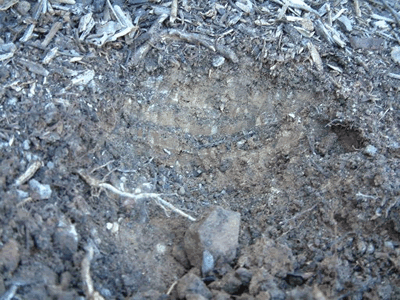Desert Soils

If you are new to the desert, our hard, dry soil may be quite a shock. If you have lived here a while, you have likely come to the conclusion that trying to change it is futile. To have a beautiful landscape, the best strategy is to quit fighting Mother Nature and choose plants that are well adapted to our native soil.
Low desert soils may have a high clay content, low organic material content (less than 1%) and a high pH (meaning the soil is very alkaline). The high clay content helps the soil to retain water and nutrients. This sounds great, but that same clay also compacts easily, can be void of vital oxygen, and can make it difficult to dig planting holes. At the other end of the spectrum, you may have sandy soils, which like clay soils have very contain little organic matter and do not retain moisture. Soils are nearly impossible to change. The likelihood you will be able change your soil texture is pretty slim. The best plan when designing your landscape is to choose plants that have evolved in the desert and are adapted to our soils. Trying to grow a plant that prefers the loose, acidic soils found back east will only end in frustration for you and death for the plant.
Organic soil amendments can improve the nutrient content, the water holding capacity and improve water penetration. Adding organic material to the backfill of planting holes was long been believed to help establish new plants. This is no longer recommended. Incorporating organic material into our soils can actually have a detrimental effect on many desert plants. Organic material is best used on the soil surface as a mulch both as a temperature and moisture regulator, and to reduce weed growth. The mulch material should be spread around plants, about two-inches deep, out to the drip line. Be careful not to put the organic material directly against the trunk or stems of the plant.
Organic material comes in many forms:
Compost – can be made at home from vegetable waste or leaves or purchased at a nursery and has a low nutrient content but improves water holding capacity.
Manure – use manure only from plant eating animals such as cows, sheep, horses, rabbits and chickens. It needs to be well aged (six months to a year) or it could damage your plants’ roots with its high salt content.
Leaves – best if composted first, but if you have leave drop in your yard, consider leaving it under your plants rather than raking it up. Leaves contain nutrients that are important for a plant’s health.
Bark Products – you can obtain this material from your local nursery or garden center. The ground bark pieces eventually interlock and will not be disturbed by the wind. Bark could be used as a total landscape cover in place of crushed granite.
A hardpan soil layer causes gardeners much grief. Hardpan is created when builders spread excavated subsoil over the soil surface and repeatedly drive heavy equipment over it. A hardpan layer close to the surface may be broken up with these steps:
1. Till the soil to a depth of 1 foot or more.
| 2. | If tilling is not possible, drill through the hardpan with a soil auger to the porous soil below. |
3. A hardpan layer may require the installation of a French drain and/or water

4. Use raised planting beds and fill in with topsoil.
You may hear the term ‘caliche’ used when discussing soils. Caliche (Ca – leach –ee) is layer of soil in which the soil particles are cemented together by calcium carbonate (CaCO3). These concrete-like pieces range in size from one inch to several feet across. Layers of caliche can be loose or may be found in solid formations. The only time caliche is a problem for plants is when the layers of material doesn’t allow water to drain through it. Aside from removing the pieces of caliche, there is no practical way to eliminate it from our soils.
Kathleen Moore
Water Conservation Coordinator
City of Chandler